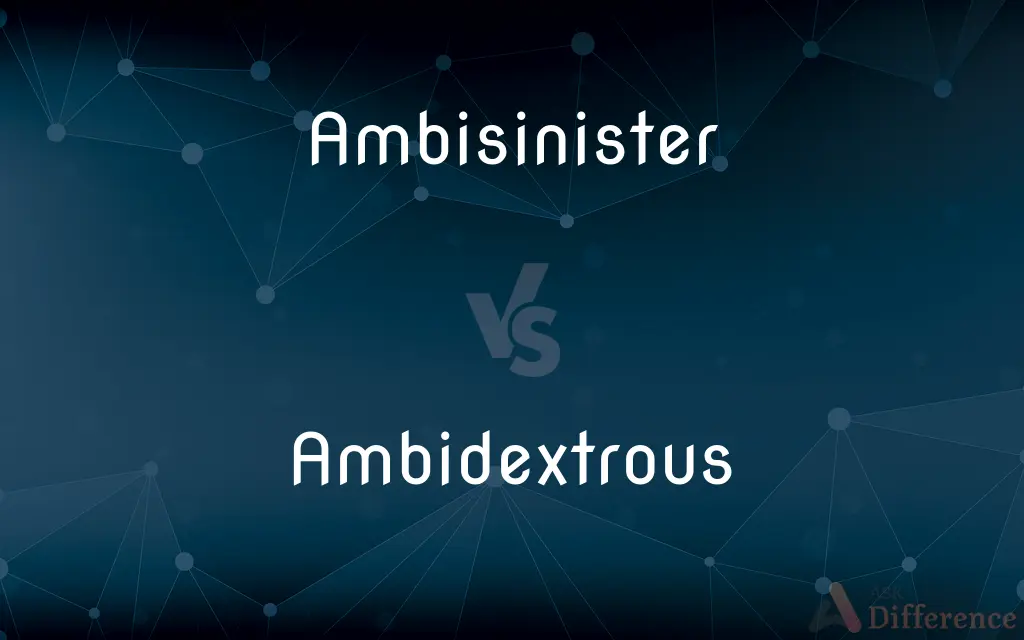Ambisinister vs. Ambidextrous — What's the Difference?
By Fiza Rafique & Urooj Arif — Updated on May 3, 2024
Ambisinister people lack proficiency with both hands, while ambidextrous individuals can use both hands with equal skill.

Difference Between Ambisinister and Ambidextrous
Table of Contents
ADVERTISEMENT
Key Differences
Ambisinister individuals experience difficulty with tasks that require fine motor skills in both hands, making activities like writing or using tools challenging , on the other hand, ambidextrous people are skilled in using both their left and right hands, enabling them to perform tasks like writing or throwing with either hand effectively.
While ambidexterity is often seen as a valuable skill, especially in sports and the arts, where using both hands equally well can be advantageous, ambisinister individuals may face challenges in activities that require good hand coordination and dexterity.
The cause of ambidexterity is typically a combination of genetics and training, with some people training themselves to become more proficient with their non-dominant hand. Conversely, ambisinister can result from a lack of dominance in either hand, leading to below-average dexterity and coordination in both.
In terms of adaptations, ambidextrous individuals can easily switch between hands for various tasks, which can prevent fatigue and increase efficiency. Ambisinister people, however, might need to rely more on tools and techniques adapted for better grip and control to compensate for their lack of hand proficiency.
Ambidexterity is sometimes associated with balanced brain hemisphere functions, suggesting a more symmetrical use of both brain halves. In contrast, ambisinister individuals might not have a dominant hemisphere for motor control, which can affect their fine motor skills in both hands.
ADVERTISEMENT
Comparison Chart
Skill Level
Low proficiency with both hands
High proficiency with both hands
Advantage
Difficulties in tasks requiring fine motor skills
Can perform tasks with either hand
Typical Cause
Lack of dominant hand leading to poor dexterity
Genetic factors and/or training
Adaptations
May require adapted tools
Can switch hands to prevent fatigue
Brain Functionality
Potential lack of dominant hemisphere for motor control
Often balanced brain hemispheres
Compare with Definitions
Ambisinister
They might find simple tasks challenging.
Using scissors is always a struggle for her.
Ambidextrous
They often excel in tasks requiring manual dexterity.
An ambidextrous surgeon can operate with both left and right hands.
Ambisinister
Ambisinister people struggle with manual tasks using either hand.
Tying shoelaces is difficult for him with both hands.
Ambidextrous
An ambidextrous person can use both hands with equal skill.
She can write her name neatly with either hand.
Ambisinister
Ambisinister individuals often compensate with other skills.
She excels in verbal communication, despite hand coordination challenges.
Ambidextrous
This trait can be beneficial in sports.
Ambidextrous basketball players can shoot from both sides.
Ambisinister
They may need specific educational support.
Special education teachers assist ambisinister children with fine motor skills.
Ambidextrous
It is sometimes linked to artistic ability.
Many famous artists are known to be ambidextrous.
Ambisinister
This trait can affect personal and professional tasks.
He uses special ergonomic tools to help with handwriting.
Ambidextrous
Ambidextrous individuals may learn to strengthen their non-dominant hand.
He practices tennis swings with both his left and right hands.
Ambisinister
(rare) Awkward or clumsy with both hands.
Ambidextrous
Able to use both hands with equal facility.
Ambidextrous
Unusually skillful; adroit.
Ambidextrous
Deceptive or hypocritical.
Ambidextrous
Having equal ability in both hands; in particular, able to write equally well with both hands.
Ambidextrous
Equally usable by left-handed and right-handed people as a tool or instrument.
Ambidextrous
(archaic) Practising or siding with both parties.
Ambidextrous
Exceptionally skillful; adept in more than one medium, genre, style, etc.
Michelangelo was a very ambidextrous artist, producing sculptures and frescoes with equal ability.
Ambidextrous
Having the faculty of using both hands with equal ease.
Ambidextrous
Practicing or siding with both parties.
All false, shuffling, and ambidextrous dealings.
Ambidextrous
Equally skillful with each hand;
An ambidextrous surgeon
A right-handed batter
Right-handed scissors
Ambidextrous
Marked by deliberate deceptiveness especially by pretending one set of feelings and acting under the influence of another;
She was a deceitful scheming little thing
A double-dealing double agent
A double-faced infernal traitor and schemer
Common Curiosities
Are ambisinister people common?
Ambisinister is less commonly discussed but is also a rare trait where neither hand is dominant.
How common is ambidexterity?
Ambidexterity is relatively rare, with only a small percentage of the population being truly ambidextrous.
Do ambisinister people face challenges in professional settings?
Yes, ambisinister individuals might find certain professions challenging, especially those requiring precise manual dexterity.
What does ambidextrous mean?
Ambidextrous refers to having equal ability in using both the left and right hands.
Can someone be naturally ambidextrous?
Yes, some individuals are naturally ambidextrous, but others may develop this skill through practice.
How do educators support ambisinister students?
Educators can provide specialized tools and techniques to assist ambisinister students in developing their fine motor skills.
What does ambisinister mean?
Ambisinister describes individuals who have poor dexterity and coordination with both hands.
What kind of jobs are suitable for ambidextrous people?
Jobs that require versatility in hand use, such as surgery, sports, or musical instrument playing, can be ideal for ambidextrous individuals.
Can training improve ambisinister conditions?
With appropriate therapy and practice, people with ambisinister traits can improve their hand usage, though they might not reach full proficiency.
Can ambidextrous people switch hands for any task?
Most ambidextrous people can switch hands for many tasks, though they might still prefer one hand for certain activities.
Is there a way to help ambisinister individuals?
Occupational therapy can help ambisinister individuals improve their fine motor skills and find ways to manage daily tasks more effectively.
Is ambidexterity hereditary?
There is some genetic component to ambidexterity, but environmental factors and training also play significant roles.
Are there famous ambidextrous individuals?
Yes, several notable figures, including Leonardo da Vinci and Benjamin Franklin, are known to have been ambidextrous.
What are the psychological impacts of being ambidextrous?
Being ambidextrous does not typically have negative psychological impacts and can be seen as a beneficial trait.
Do ambisinister individuals have any advantages?
While there are challenges, some ambisinister individuals may develop unique problem-solving skills or other compensatory abilities.
Share Your Discovery

Previous Comparison
Gypsy vs. Hippie
Next Comparison
Clutch vs. BrakeAuthor Spotlight
Written by
Fiza RafiqueFiza Rafique is a skilled content writer at AskDifference.com, where she meticulously refines and enhances written pieces. Drawing from her vast editorial expertise, Fiza ensures clarity, accuracy, and precision in every article. Passionate about language, she continually seeks to elevate the quality of content for readers worldwide.
Co-written by
Urooj ArifUrooj is a skilled content writer at Ask Difference, known for her exceptional ability to simplify complex topics into engaging and informative content. With a passion for research and a flair for clear, concise writing, she consistently delivers articles that resonate with our diverse audience.
















































